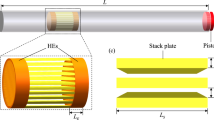Abstract
In this study, we propose an adaptive recurrent neural networks synchronization of H-mode and edge localized modes that is important for obtaining a long-pulse tokamak without disruption regime. The deterministic part of the plasma behavior should be synchronized with stochastic part by introducing stochastic artificial neural network.
Similar content being viewed by others
References
Garabedian PR (1994) A unified theory of tokamaks and stellarators. Commun Pure Appl Math 47(3):281–292
Rastovic D (2007) Optimal control of tokamak and stellarator plasma behaviour. Chaos Solitons Fractals 32(2):676–681
Baek J (2010) Adaptive fuzzy bilinear feedback control design for synchronization of TS fuzzy bilinear generalized Lorentz system with uncertain parameters. Phys Lett A. doi:10.1016/j.physleta.2010.02.014
Wang L, Ding W, Chen D (2010) Synchronization schemes of a class of fuzzy cellular neural networks based on adaptive control. Phys Lett A. doi:10.1016/j.physleta.2010.01.029
Rastovic D (1999) Fuzzy simulation of spatiotemporal behavior. Stabil Contr Theory Appl 2(1–2):53–58
Jaynes ET (1957) Information theory and statistical mechanics. Phys Rev 106(4):620–630
Rodder W (2000) Conditional logic and the principle of entropy. Artif Intell 117:83–106
Rastovic D (2003) Infinite fuzzy logic controller and maximum entropy principle. InterStat(Virginia)
Rastovic D (1999) Elastic fuzzy logic controllers in the space L¹[I]. Development and practice of artificial intelligence techniques, IAAMSAD, Durban, pp 267–268
Rastovic D (1993) Compensators for contractive systems. Cybernetica 36(1):11–15
Tino P, Cernanski M, Benuskova L (2004) Markovian architectural bias of recurrent neural networks. IEEE Trans Neural Netw 15(1):6–15
Rastovic D (2009) Fuzzy scaling and stability of tokamaks. J Fusion Energy 28(1):101–106
Rastovic D (2008) Analytical description of long–pulse tokamaks. J Fusion Energy 27(4):285–291
Unterberg EA, Schmitz O, Evans TE et al (2010) The effects of an open and closed diverter on particle exhaust during edge-localized mode suppression by resonant magnetic perturbations in DIII-D. Nucl Fusion 50:034011–034020
Katsuro-Hopkins O, Sabbagh SA, Bialek JM et al (2010) Equilibrium and global MHD stability study of KSTAR high beta plasmas under passive and active mode control. Nucl Fusion 50:025019–025028
Author information
Authors and Affiliations
Corresponding author
Rights and permissions
About this article
Cite this article
Rastovic, D. Targeting and synchronization at tokamak with recurrent artificial neural networks. Neural Comput & Applic 21, 1065–1069 (2012). https://doi.org/10.1007/s00521-011-0527-4
Received:
Accepted:
Published:
Issue Date:
DOI: https://doi.org/10.1007/s00521-011-0527-4




